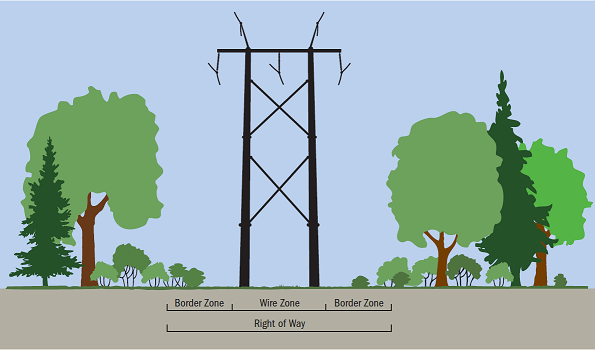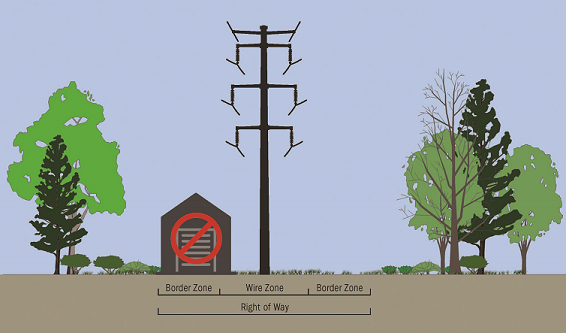Right-of-Way, Easements and Encroachments
With more than 20,000 miles of transmission lines in ten states, we will operate our transmission infrastructure safely, providing reliable electricity for our customers. Establishing and maintaining rights-of-way, easements and encroachments for transmission lines is important to meeting that goal.
What is a right-of-way?
The land underneath a transmission line is called a right-of-way. We acquire the right-of-way to build and operate our transmission facilities in a safe and reliable manner. In most cases, Xcel Energy has an easement on the property where the transmission line (and right-of-way) is located, or Xcel Energy may own the right-of-way in fee.
What is an easement?
An easement is a permanent right authorizing a person or party to use private land or property of another for a particular purpose. In this case, a utility acquires certain rights to build and maintain a transmission line. Landowners are paid for the easement and can continue to use the land for most purposes, although some restrictions are included in the agreement.
If specific property is encumbered by a blanket easement and the easement does not include a definite and specific description of the location or width, a landowner may submit an easement definition request.
What is an encroachment?
Any use of the property under a transmission line that is not permitted in the terms of the easement is considered an encroachment and must be approved by Xcel Energy. When a property owner would like to make changes to the land – by planting trees or shrubs or building something on the right-of-way – permission must be granted by Xcel Energy. In some cases, Xcel Energy may own the land in fee that hosts electric facilities. Requests to encroach on fee-owned property typically take longer to review, are determined on a case-by-case basis and may not be approved. Encroachment requests are reviewed individually, and requirements will vary from case to case. For more information and to apply for an Encroachment Review, please visit the Encroachments Review page.

The corridor underneath a transmission line must be clear of all structures and some vegetation for crews to safely access and maintain the transmission line when there is an emergency and to prevent possible electrical outages from unsafe items in the right-of-way. Planting non-compatible vegetation in the border zone or wire zone of a transmission right-of-way will likely require removal.

Building a shed within the border zone is an incorrect use of a right-of-way. If a building or structure in the right-of-way caught fire, it could burn into the power line, taking the line out of service for an extended time. Additionally, placing buildings or other structures, vehicles, campers and other items in the right-of-way, could hamper maintenance crews from accessing the line when needed.
Defining a Transmission Line
Electric power transmission lines or Transmission Lines are the system of structures, wires, insulators, and associated hardware that carry electric energy from one point to another in an electric power system. Lines are operated at high voltages varying from 69 kV up to 500 kV and are capable of transmitting large quantities of electricity over long distances.
A “Transmission Structure,” “Transmission Line Structure”, “Structure”, or “Transmission Facility” is defined as any asset, facility, or infrastructure owned, operated, and maintained by Xcel Energy. This is typically synonymous and inclusive of the following terms: pole, wood pole, steel pole, tower, foundation, guy wire, anchor, ground wire, facility, equipment.
A “Transmission Line,” “Line”, or “Circuit” may refer to the high voltage transmission line system as a whole including the structures, foundations, and wires, and may also simply refer to the conductors or wires supported by the structures and suspended overhead.
Overhead “Conductors,” “Wires”, or “Lines” typically refer to the high voltage wires suspended overhead. This may include both the overhead wires conducting electricity and overhead “ground” or “shield” wires that do not conduct electricity.
Powerline Trails
In Colorado, the Powerline Trails Act (HB 22-1104) was passed in 2022 to help raise awareness and create opportunities for public entities – defined as “the state, a local government, or a district” – to co-locate public recreation trails within transmission corridors.
When Xcel Energy seeks to site a new transmission line or expand an existing transmission line within a local jurisdiction, the company will (1) notify local governments of the potential for construction of a powerline trail within the transmission corridor; and (2) help inform the public entities of the guidelines for which a trail can safely co-locate within the transmission corridor. Powerline trails may ultimately be constructed by public entities after consulting with Xcel Energy, the Colorado Division of Parks and Wildlife, and landowners about the safety and feasibility of such trails, and after the transmission corridor is constructed. To co-locate a public recreation trails within an Xcel Energy transmission corridor, the public entity must follow the company’s Guidelines – Electric Transmission Line Right-Of-Way Us (PDF) and safe practices (PDF) around power lines. Examples of existing powerline trails in Colorado may be found here (PDF).
Important References and Documents
Safe Practices Around Power Lines
Vegetation Management Information
Encroachment Review Timeline (PDF)
Transmission Encroachment Application
Transmission Encroachment Guidelines
Contact Us
If you have questions about what you can do in the transmission right-of-way, please email or call us with questions.
Minnesota, Michigan, North Dakota, South Dakota, Wisconsin
midwestrightofway@xcelenergy.com
612.330.6007
Colorado
coloradorightofway@xcelenergy.com
303.571.7240
New Mexico, Texas, Oklahoma
southwestrightofway@xcelenergy.com
806.640.6606